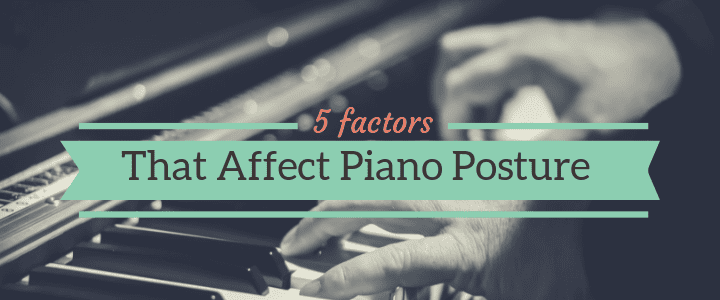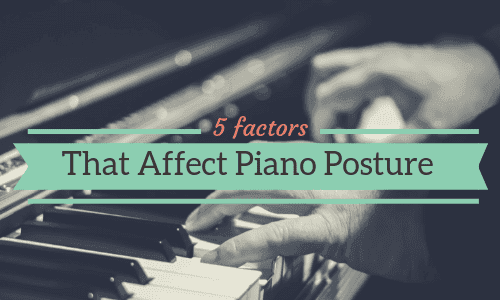
Proper piano posture: the words alone are enough to make any pianist wince, straighten up, and make every effort to maintain it, at least for a few minutes.
You may not realize that when you’re playing the piano, your posture is a key factor in your technique and whether or not you feel at ease practicing the instrument.
Because practicing is a repetitive activity, it’s important to do it well. Otherwise, you risk reinforcing bad habits through repetition. If you struggle with maintaining proper piano posture over time, it could lead to pain and injury.
When your body is in an optimal relationship to the bench, the ground, the pedals, and the keys, you develop ways of executing challenging passages with coordination, skill, and grace without as much effort. Let’s take a look at how to improve our piano posture.
5 Factors That Affect Piano Posture
Slumping at the piano is an obvious no-no, but there are a few additional factors that you probably haven’t considered relevant to your piano posture.
Recognizing these factors and making adjustments can create a significant difference in feeling poised and comfortable at the piano. The best part is, these changes are all very easy to implement into your routine!
1. Your Bench
The first culprit to proper piano posture is often your bench (or lack thereof). The bench is the last thing someone considers when buying a piano or keyboard. You may not even have a bench at all!
Remember that the bench is an integral part of the piano, and it’s important to find one that’s a good fit for you. A good option for many people is an adjustable bench, which you can tailor to any player’s height. This ensures that your hand and wrist positioning are correct, so that you can make a good tactile connection to the piano and avoid repetitive stress injuries.
Your bench is also a source of stability.
Your sitting-bones (at the bottom of your pelvis) give you strength to play forcefully when needed. Standing up while playing is particularly hazardous, since you’re forced to look down at the piano and bend your arms at an awkward angle to reach the keys.
One other common problem is using a chair instead of a bench. While not the worst option, this can also negatively affect your posture, particularly if you have a tendency to recline into the backrest while playing. As you can see, your bench can make a big difference in your ability to stabilize, connect to the piano, and draw the music from your whole body, not just your hands.
2. Practice Session Length
Another critical factor that’s often missed when thinking about correct piano posture is how long you’ve been seated. Playing for extra long periods of time can wreck anyone’s posture, even those who started with good posture at the beginning of the practice session.
This is especially true for beginners, since the amount of concentration needed to execute your playing makes it challenging to also dedicate attention to your posture.
At the end of a long practice session, you might find yourself over-focused at the piano, with your neck drawn forward to your music and your spine collapsed. Luckily, this hidden factor in piano posture is easily fixed.
Take frequent breaks, set a timer if needed, and build up to longer playing times as your body adjusts and forms good habits.
3. Not Using a Footstool
This next surprising pitfall is particularly key for children and shorter adults at the piano. Are your legs dangling from the piano bench? This is a big red flag! Just like the bench helps you to stabilize your body, so does the ground.
If you’re not touching the ground, you’re losing a place to release your weight into while maintaining an upright posture.
Being upright at the piano actually starts from the ground, and an adjustable footrest is an excellent solution.
Not using a footstool when it’s needed means you’ll be putting a lot of effort and strain into your upper body. You may even find that your legs are tense, as you can get into the habit of holding them up while they dangle in the air.
4. Lack of Exercise
Another factor you may not have considered actually happens outside of piano practice. Have you ever thought about physical fitness as a part of maintaining good posture at the piano?
Playing the piano is an endurance sport of your small muscles, as well as your spine and upper body.
Exercising allows you to release any tension from your practice session and encourage circulation.
Another reason to exercise outside of your piano practice goes back to the idea of repetition. Since you’re exercising certain muscles repeatedly at the piano, it’s important to vary your workout so you can avoid tension from over-strengthening certain muscles.
5. Your Position on the Bench
Lastly, it’s important to take a few minutes to notice how you’re sitting on the bench. A big factor in correct piano posture is to make sure you don’t just have the right equipment, but that you’re also using it well.
If you’re sitting too far back on the bench, this can have a detrimental effect on your posture.
Why? Just like you don’t want to be collapsed forward and leaning too far into the piano, it’s equally important not to lean back and over-straighten your arms.
This position strains your connection to the keys and causes too much effort to maintain your posture. It also throws off the positioning of your head, as your head may crane forward to compensate for your backwards stance. Yikes!
Final Tips & Tricks
Now that you’ve seen some sneaky causes of bad piano posture, here are a few tips that will help you reduce strain in the future. With these tips, you’ll feel better and look effortlessly graceful at the piano, too!
- For pianists who feel that the weight of the music lies in their shoulders, try to release your upper body weight into the bench, so your shoulders can release and widen.
- You can do the same with your feet by allowing them to release into the ground, so your legs feel free instead of tense.
- Allow your head to rest easily on top of your spine and try to avoid pulling your neck forward, toward the music.
- Let your eyes view the music with a wide, easy gaze so the muscles of your head and neck can release.
Having correct piano posture is very important, and if you feel like you need some more attention in this area, a qualified piano teacher can help you overcome these challenges and improve your technique.
 Post Author: Nadia B.
Post Author: Nadia B.Nadia B. teaches local and online piano lessons in New York, NY. She has been teaching since 2003, and has a degree in Music Performance from New York University. Learn more about Nadia here!
Jessica Dais
